the Kryptonite Lock Story
|
|

|

![]()
This article, the story of the early days of the Kryptonite bicycle lock, was first published in 1988 in Bicycle Guide magazine. The article is republished here with several more pictures than appeared in the magazine.
For the umpteenth time, Bicycle Guide contributing editor Sheldon Brown and I are talking about bicycles in his basement workshop. On the wall, I notice something that looks like an old, flat-metal Kryptonite lock, only thick, clumsy and rusty. Sheldon tells me that it is, in fact, one of the first fifty Kryptonite locks ever made, and that he bought it from Stan Kaplan, the inventor.
Back in 1971, Sheldon explains, he and Stan worked as mechanics at the old Bicycle Revival store in Cambridgeport, Massachusetts.
"Stan was just a bicycle mechanic at the time, but then bicycle mechanics have a good track record for inventing interesting things -- Henry Ford, the Wright Brothers. You should see Stan count bearing balls. In pharmacy school, you learn to count pills." Sheldon demonstrates with rapid hand motions in midair.
"Of course, there had been long-shackle padlocks to lock the bicycle to itself, but as far as I know he was first to design one to lock it to a fixed object."
![]()
![]()
A few days later, I ring the doorbell of Stan's third-floor apartment in East Cambridge. A slim man, he is dressed in khaki trousers and a T-shirt. "My original SK Associates T-shirt," he says. "I put it on especially for this occasion." He leads me into the homey, slightly cluttered kitchen.
Stan Kaplan displays one of the earliest Kryptonite locks.
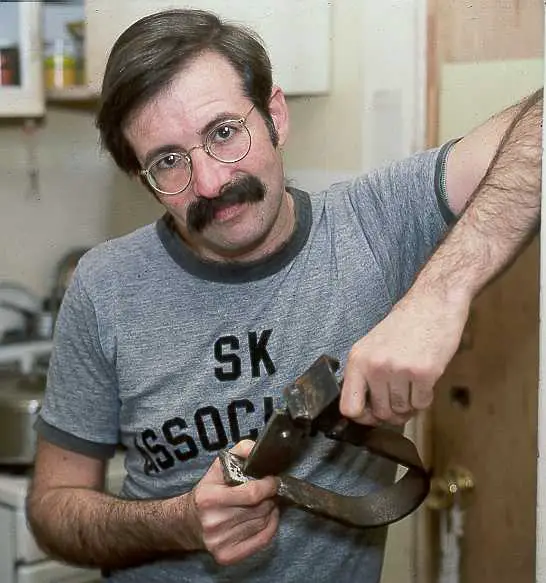
He called his one-man company SK, he tells me, before he called it Kryptonite. He walks quickly around the kitchen, boiling a pot of tea and keeping a watchful eye on a pressure cooker of brown rice as he expands on Sheldon's story.
![]()
![]()
Afternoons and summers while in high school, Stan worked in his uncle's Western Auto store, a Raleigh dealership; then attended pharmacy school. "I liked pharmacy work with my father -- just before the chain stores came in, before the drug robberies." But after three years, Stan quit, tired of the "heavy memorizing" and pill counting. "I was terrible at memorizing."
A couple of jobs later, his Raleigh mechanic's certificate landed Stan his job at the Bicycle Revival.
Stan describes the moment of invention: "It was 1971, toward the end of the season. Some woman came in -- her bike had been stolen -- with the idea of using a very large block of aluminum in a U-shape. You know what was being used then: cheap chain, cheap cable locks, or good chain and a heavy lock.
"It just occurred to me, bolt cutters were the most-used tool, so you don't use a rod: you use bar stock. The U shape was the easy part. One day at the Revival, I went outside and measured a parking meter so the lock would go around it but not over the head. Then I had to think about how to close it off."
"I knew I was going to use a padlock. I happened to go to New York City that weekend. In a subway station, I saw vending machines with a bulky housing around a padlock, to stop bolt cutters." Kaplan shows me an early patent drawing, illustrating all of these features.
A 1971 patent drawing shows the unique features of the early Kryptonite lock:
the U-shaped, flat steel shackle, the crossbar and the "bonnet"
designed to protect a padlock from attack with bolt cutters.
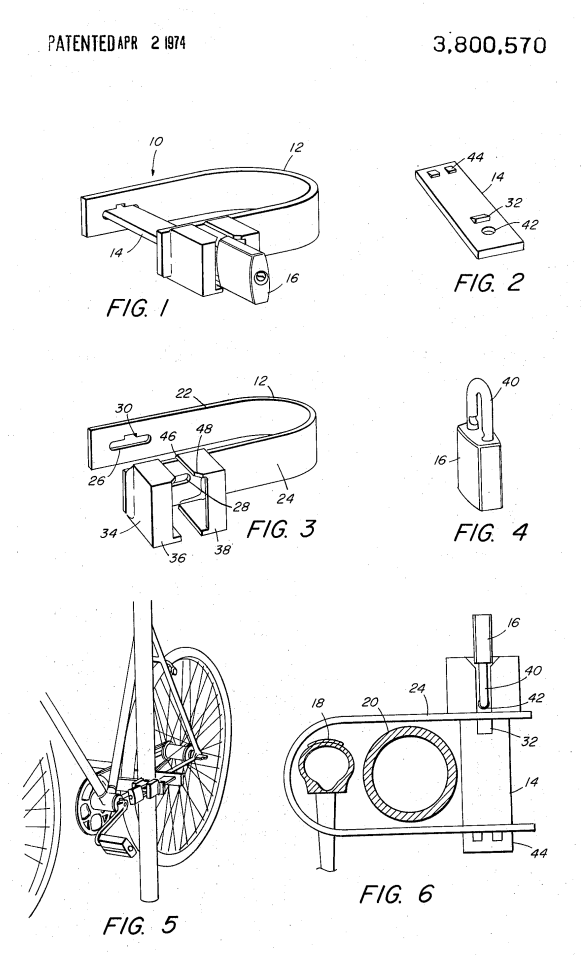 |
"By the fall, I had 50 locks already made. Over the winter, I started in earnest." Stan tried to do as much of the work as possible by himself, planning a run of 200 locks. He enlisted a friend to help with milling in a borrowed machine shop. He improved the design, going to lighter, hardened 1/8-inch-thick stainless steel. Looking back now, he realizes that there was no way he could make locks fast enough.
Then Michael Zane called, having read a newspaper article about the lock. Zane's family owned a Boston sheet-metal shop which had specialized in fluorescent lighting fixtures. Soon Kaplan and Zane signed a partnership agreement. Kaplan turned over his supplies to the Zane family business. Zane undertook a nationwide tour in a VW bus, visiting bicycle shops to drum up interest in the lock. Business grew step by step. But there wasn't much work for Kaplan.
A reader has sent in a picture of an early version of the Kryptonite 2 lock, made by Zane's company. This has a tapered "bonnet" for the padlock.
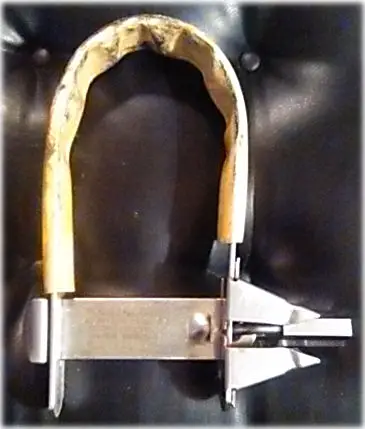
A later version had a rectangular bonnet as shown in the promotional flyer below.
Second version of the Kryptonite lock,
in an promotional flyer -- still patent pending. The
company name is still SK Associates but the address is that
of the Zane business which commercialized the lock.
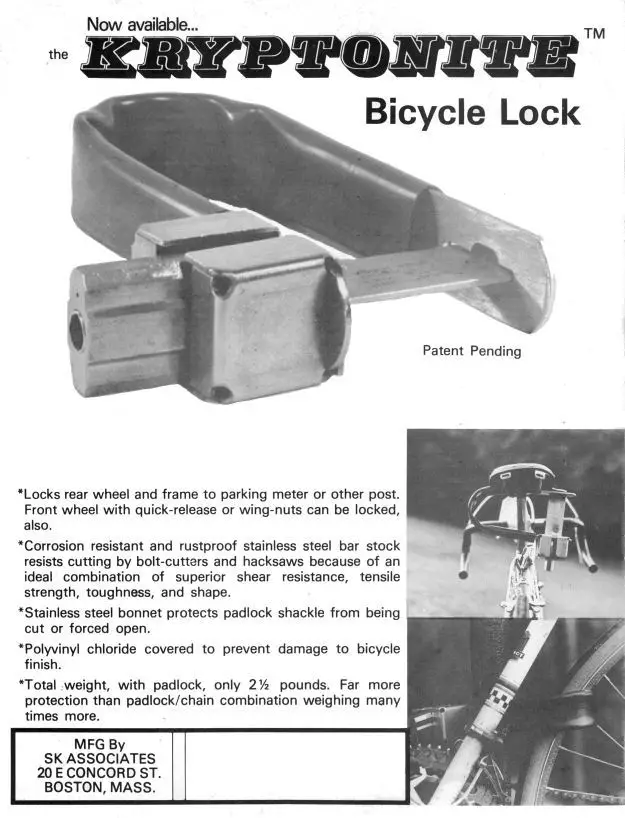 |
![]()
![]()
After a year, Zane bought Kaplan out, with royalties to be paid on locks manufactured. As improvements supplanted the ideas in Kaplan's original patent, his royalty share decreased.
The third version of the Kryptonite lock had an integral locking cylinder.
Flat-steel Kryptonite locks were designed to fit neatly into the
Pletscher rack, the most common rear rack in the 1970s.
Kaplan is philosophical about this. "I don't want to be rich; I'm doing ok without it. The lock money has allowed me to not work consistently, taken the pressure off. My mother says 'You could have been a millionaire!' I could also have had ulcers. I like to do different things, so I'm happy it happened this way."
Even while still Zane's partner, Kaplan was pursuing other interests, as co-founder of a Cambridge self-service bike repair shop. He has worked varied jobs and taken long vacations, including one summer on a motorcycle and others on his sailboat -- maintained with loving care rather than large amounts of cash.
Kaplan now supports himself as a freelance typist and computer instructor. "I'm tutoring a kid downstairs," Kaplan tells me, a proud glint in his eye.
The small sign, KBL Corporation, is screwed to the gray metal-clad fire door of a boxy, gray asphalt-shingled building south of the Boston city center. The door opens on a wooden stairway. Hearing the thump, clatter and whir or machinery, I pause and look through an open door to my right. In a large room with an oily floor, men in blue overalls stand at huge metalworking machines. Piles of metal rod are stacked in barrels.
Up a flight of stairs, I enter a large, brightly fluorescent-lighted room with a fresh-plywood floor, where women sit behind desks. Boxes of floor tiles stand in a corner.
The receptionist summons Michael Zane. Tall, with thinning, curly hair and a mustache, Zane strides over to greet me, gestures at the floor a bit nervously and apologizes for the office renovation. Then he lets on that it is overdue. "In 1975, the Boston Redevelopment Authority said we had to move; they were going to build a new building. They tore down our old one. It's still an empty lot. But this building is solid -- over 100 years old. Huge timbers, to support the machines."
I'm impressed by the frugal efficiency of this plain, solid, old building, though I can't help but think that Zane is concerned that his company should have a plush, red carpet to roll out for this reporter.
We settle in Zane's small, tidy office and he talks Kryptonite history. He begins to relax. "Kaplan had the right idea when he started. He preceded others by years. You could carry it in a pack, or on your Pletscher rack. It was unique."
In his office, Michael Zane holds the K4, first manufactured in 1978.
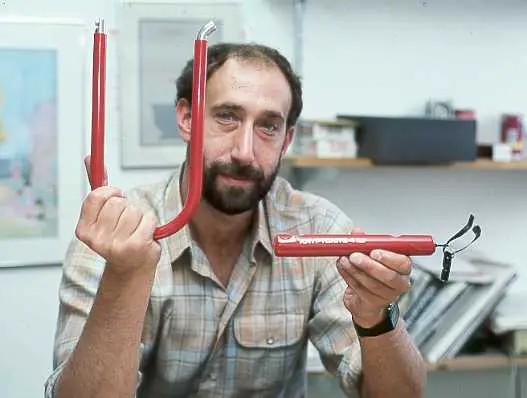
I ask about Zane's 1972 market-research tour, in a VW bus. He recalls the times: "In 1972, I was kicked out of bike stores in Connecticut, out of Pill Hardware, Commonwealth Lock" -- two of Cambridge's best hardware stores. But Boston-area bike shops picked up on the lock. Zane made sales "only where dealers were knowledgeable and saw that bike theft was a problem."
The early years weren't easy: an old Boston Globe article describes Zane as an obsessed man, with a cluttered office and dark circles under his eyes.
"We started with 100 locks to the Bicycle Exchange," he tells me. "In the first year we made 1500 locks. 65 percent went to Boston, 20 percent to New York... Now we sell more than 100,000 per year, but that includes the ones for Harleys and Kawasakis. The majority of our business is in the bicycle and moped market. In 1975, we had 15-20 employees. To keep up the volume of business for the first six or seven years, we sold other accessories: Allen racks, coiling cable, Avanti Panniers, gloves, Kobe bikes."
To promote the lock, Zane drew on his art-major college background for some inspired hucksterism. In 1972, a New York bike shop contracted to put the lock to the ultimate test, a Greenwich Village signpost. Though removable parts of the bike were stripped, the lock and bike were still in place after thirty days. This event, carefully staged and followed up, gave the lock its first major national exposure.
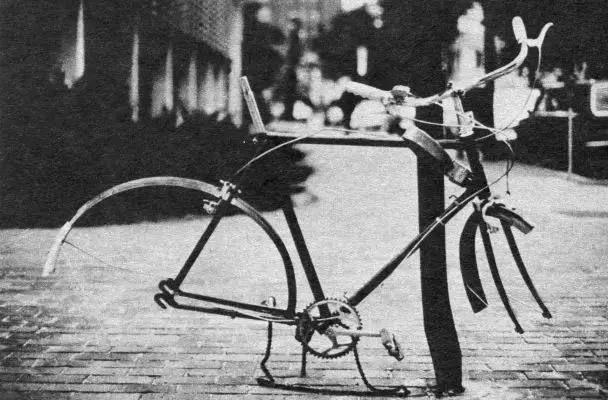
Visiting the Chicago offices of Playboy magazine, Zane disappeared into the men's room and emerged wearing a Superman suit with a green leotard, a velvet cape, red shoes and huge K on the chest. Heads turned as he walked out through the office.
In this 1975 photo, Michael Zane models the Superman suit
which turned heads at Playboy magazine's offices.
(Photo by Henry Horenstein, courtesy Boston Globe. --
Boston Globe Magazine, February 9, 1975, p. 17)
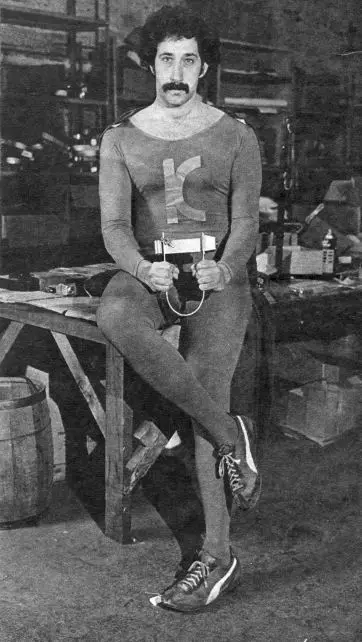
Hurrying back to the airport in a minibus, he gave the other passengers a ride to remember. He stripped off his raincoat, revealing the costume, then dumped the cape into a briefcase and pulled on his street clothes over the leotard. The June, 1974 Playboy carried a note about the lock.
![]()
![]()
Here's a flashback to 1972. I, John Allen, am an engineering student at MIT: as I extract my three-speed from a campus bike rack, a shortsleeve- and chino-clad fellow reads me a questionnaire: "how much would you spend for a bike lock...how heavy ... ?"
Serious competition for the Kryptonite lock began, improbably enough, with a design and marketing project at the MIT business school. The MIT lock had one major selling point: it secured both of the bike's wheels in place. It looked like a medieval torture instrument, weighed several pounds and occupied all three sides of a bike's front triangle. A few actually were produced.
Zane continues: "Ray Seakan, the marketing graduate student who had led the MIT lock project, decided that he could do better." Seakan founded Citadel, Kryptonite's main competitor.
Citadel bicycle lock promotion -- bar stock,
and the foot passed through the crosbar.
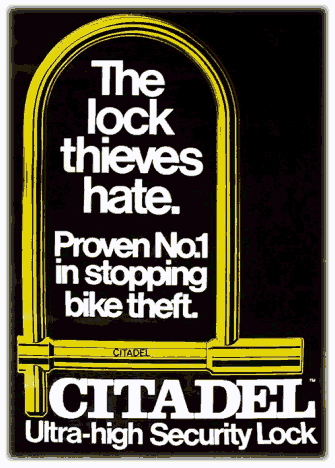
The Citadel lock had the same U shape as the Kryptonite, but its shackle and crossbar were of 1/2-inch high-strength round steel stock, thick enough to foil bolt cutters. In this way, Seakan avoided infringing on Kaplan's patent. The Citadel lock was easier to use than the early Kryptonite, since the U-bar slid smoothly into the crossbar. Other competitors -- Good Lock, Valex -- come and go, but Citadel -- recently bought out by Rhode Gear -- continues to this day.
Zane countered the competition with a frame-mounted carrying bracket for the Kryptonite, in 1978. Soon after, he went over to making his locks of round rod, too. Round rod was necessary to use a full vinyl coating, which would wear off the edges of a flat U-bar. "We designed the product to fit the coating, and the bracket to fit the lock. Earlier, we had a plastic sleeve, which worked ok if used properly."
Zane also claims that the current Kryptonite model is even easier to use than the Citadel. "On the Citadel, you have to thread the U-bar into two parallel holes...the fourth version of the Kryptonite lock differs in ease of use. It has more angles of attack."
This is the lock which, as Zane is happy to explain, was accepted into New York's Museum of Modern Art Design Collection. "It's on permanent display at the Museum..." He describes how he enlisted his former college art professor to bring the K4 to the attention of the collection's judges.
I look through the Design Collection's catalog. The other items are fancy Italian wineglasses, modern furniture, sculpted telephones and suchlike. Zane pauses to give me time to express my appreciation. I recall how he gave up his art career and joined the family business, and, as I imagine, not entirely without regrets.
Zane demonstrates the Kryptonite's locking foot. He bristles with the healthy commercial rivalry which has brought continued improvements at both Citadel and Kryptonite.
The bent locking foot of the Kryptonite 4 made it easier to use than the Citadel
"The significant points about this lock are that it is reasonably light in weight; two pounds are one percent of the weight of the bike and rider. Carrying devices -- it fits inside the frame of most bikes, with a water bottle and pump. It doesn't significantly affect the aerodynamics..."
He points to a positive achievement of the Kryptonite lock and its imitators: "Bike theft in Cambridge, New York, Washington has been dropping since the 1970's."
"We're no Blackburn, Bell, Rhode Gear or Phil Wood. You have to make a lot of locks. We persevered because it's a family business, because of my personal goals. My brother got involved, and I couldn't walk away.
"Because a certain part of the market promotes the bicycle as a toy, it gets lip service from a lot of people -- for example, universities. As a product is less valuable, information about it becomes more scanty. We're fighting for survival in the market until we can get information to improve the design."
Zane believes that his company's biggest problem is to convince enough people to buy a U-lock when cheaper alternatives are available. "The company's main problem is education. The U-shaped lock is still only a minute fraction of the market. Pedals and derailleurs come with the bike; there's no education factor to get people to buy them. When the factor of education becomes a large part of reaching the market, you have a problem, so our thrust is education."
In the fifteen years of the U-lock, more and more bicyclists have become educated: too often, the lesson was given by a thief who cut or smashed a flimsy lock; or by the dead weight of a heavy chain and padlock slung over the shoulder, making bicyclists look like Marley's ghost from "A Christmas Carol." Thanks to Stan Kaplan, Michael Zane -- and their competitors -- the Marley's Ghost look is no longer in fashion.
![]()
![]()
Last Updated: by John Allen